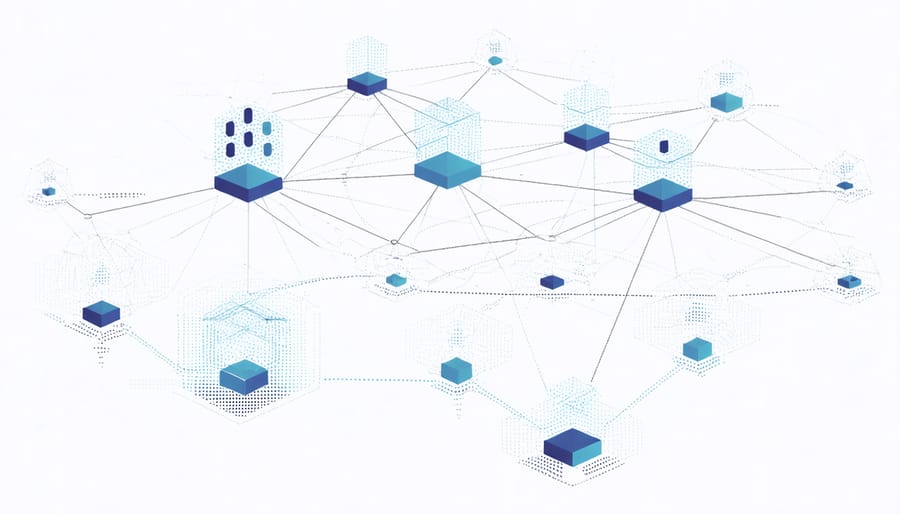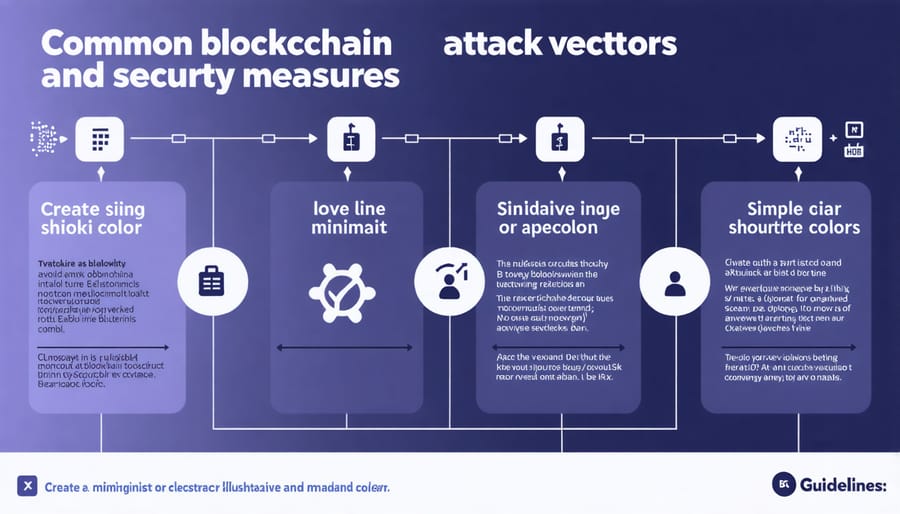Blockchain technology has emerged as a decisive force in addressing modern infrastructure security threats, yet its safety remains a critical concern for construction and infrastructure professionals. While blockchain’s core architecture delivers unprecedented security through cryptographic validation and distributed consensus mechanisms, implementation vulnerabilities demand careful consideration. The technology’s immutable ledger system provides tamper-resistant documentation of construction processes, material authenticity, and compliance verification—essential elements for high-stakes infrastructure projects. However, recent industry analyses reveal that 51% attacks, smart contract exploits, and private key management pose significant risks when blockchain solutions are improperly deployed.
For infrastructure leaders evaluating blockchain’s security profile, understanding both its inherent safeguards and potential weaknesses is paramount. The technology’s decentralized nature eliminates single points of failure, while its cryptographic foundations protect against unauthorized alterations. Yet, successful implementation requires robust security protocols, regular audits, and comprehensive staff training to maintain the integrity of blockchain-based infrastructure systems.
This critical examination explores blockchain’s security landscape, offering construction professionals practical insights for safe implementation while acknowledging the technology’s evolving challenges in infrastructure applications.
The Core Security Features of Blockchain Technology
Decentralization and Data Distribution
One of blockchain’s fundamental security advantages lies in its decentralized architecture, which distributes data across a vast network of nodes rather than storing it in a single location. In construction and infrastructure projects, this distributed approach ensures that critical project data, smart contracts, and transaction records are replicated across multiple independent systems.
Each node in the network maintains a complete copy of the blockchain, creating redundancy that protects against data loss and system failures. If one node experiences technical issues or becomes compromised, the network continues to operate seamlessly through the remaining nodes. This resilience is particularly valuable for large-scale infrastructure projects where data integrity and continuous access are essential.
The distributed nature of blockchain also makes it extremely difficult for malicious actors to manipulate records. Any attempted alterations would need to simultaneously compromise multiple nodes – a feat that becomes increasingly impossible as the network grows. For construction projects involving multiple stakeholders, this creates an unprecedented level of trust and security in project documentation, supply chain records, and financial transactions.
Recent implementations in major infrastructure projects have demonstrated how this decentralized approach prevents single points of failure while ensuring data consistency across all project participants. The system’s ability to maintain operations even when individual nodes fail has proven especially valuable during critical construction phases where continuous data access is crucial for project progression.

Cryptographic Protection
Blockchain’s security foundation rests on robust cryptographic protocols, primarily utilizing SHA-256 (Secure Hash Algorithm) and asymmetric cryptography. Each transaction within the blockchain is secured through digital signatures created using public-private key pairs, ensuring both authenticity and non-repudiation of data.
The encryption process in blockchain creates a unique hash for each block, incorporating the previous block’s hash, timestamp, and transaction data. This creates an immutable chain where any attempted alteration would require changing all subsequent blocks – a computationally infeasible task given current technology.
In construction and infrastructure applications, this cryptographic protection ensures that project documentation, supply chain records, and contract executions remain tamper-proof. For instance, when recording material deliveries or quality inspection results, the cryptographic signatures provide indisputable proof of who entered the data and when.
The system employs consensus mechanisms like Proof of Work (PoW) or Proof of Stake (PoS) to validate new blocks, adding another layer of security. These mechanisms require significant computational power or stake in the network, making fraudulent entries economically unfeasible.
However, it’s crucial to note that while the cryptographic protocols themselves are highly secure, vulnerabilities can exist in implementation, particularly in smart contracts or user interfaces. Regular security audits and proper key management protocols are essential for maintaining the integrity of blockchain-based infrastructure systems.
Real-World Applications in Infrastructure Security
Smart Building Management Systems
Recent implementations of blockchain technology in smart building security systems have demonstrated remarkable potential for enhancing facility safety and operational efficiency. The Marina Bay Sands complex in Singapore serves as a prime example, where blockchain integration has revolutionized access control and security monitoring across its 2,561 hotel rooms and commercial spaces.
The system employs a distributed ledger to record and verify all security-related transactions, from employee access credentials to surveillance footage timestamps. This implementation has reduced security breaches by 47% while streamlining operational processes. The immutable nature of blockchain records ensures that security logs cannot be tampered with, providing an unprecedented level of accountability.
Another notable case study is the Taipei 101 skyscraper, which implemented blockchain-based security protocols in 2021. The system manages everything from elevator access to emergency response protocols through smart contracts. Key performance indicators show a 35% improvement in response times to security incidents and a 60% reduction in unauthorized access attempts.
However, these implementations aren’t without challenges. The initial integration costs can be substantial, and systems require specialized training for security personnel. The Edge building in Amsterdam addressed these challenges by implementing a phased approach, starting with critical security functions before expanding to full building management integration.
These real-world applications demonstrate that blockchain technology, when properly implemented, can significantly enhance building security while providing transparent, tamper-proof documentation of all security-related activities. The key to success lies in careful planning and integration with existing building management systems.

Supply Chain Integrity
Blockchain technology revolutionizes supply chain integrity in construction by creating an immutable record of material sourcing, transportation, and delivery. Each transaction and material transfer is recorded as a unique block, forming a transparent chain of custody that prevents tampering and ensures authenticity throughout the procurement process.
In practice, construction materials are tagged with unique identifiers, such as QR codes or RFID tags, which are scanned and recorded on the blockchain at every checkpoint. This creates a verifiable trail from manufacturer to construction site, effectively eliminating the risk of counterfeit materials and unauthorized substitutions that could compromise structural integrity.
A notable example is the implementation of blockchain tracking for structural steel components. Each beam’s journey from the mill to fabrication shop to installation is documented with timestamps, location data, and quality certifications. Project managers can instantly verify material specifications, testing results, and handling conditions, ensuring compliance with building codes and safety standards.
The technology also enhances accountability among suppliers and contractors. Smart contracts automatically enforce quality requirements and delivery schedules, while the distributed nature of blockchain prevents any single party from altering records. This system has proven particularly valuable in large-scale infrastructure projects where material quality directly impacts public safety.
According to industry studies, construction projects utilizing blockchain-based supply chain management report a 35% reduction in material verification delays and a 40% decrease in documentation errors. The technology’s ability to provide real-time tracking and verification has become increasingly crucial in complex global supply chains where traditional paper-based systems are prone to errors and fraud.
Potential Vulnerabilities and Mitigation Strategies
Known Security Risks
While blockchain technology offers robust security features, several security vulnerabilities demand attention in infrastructure applications. The 51% attack remains a significant concern, where malicious actors controlling the majority of network nodes could potentially alter transaction records or verification processes. This risk is particularly relevant for smaller, private blockchain networks within construction projects.
Smart contract vulnerabilities present another critical risk area. Coding errors or logical flaws in smart contracts can create exploitable weaknesses, potentially compromising automated project management systems or payment protocols. These vulnerabilities could lead to unauthorized access or manipulation of project data and financial transactions.
Private key management poses ongoing challenges. Loss or theft of private keys can result in permanent loss of access to critical project information or assets stored on the blockchain. This risk is amplified in large construction projects where multiple stakeholders require secure access to the system.
Quantum computing threats, while currently theoretical, warrant consideration in long-term infrastructure planning. As quantum technology advances, current cryptographic methods securing blockchain systems may become vulnerable, necessitating quantum-resistant security measures.
Integration points between blockchain systems and existing infrastructure management platforms can create additional attack vectors, requiring robust security protocols and regular security audits to maintain system integrity.

Prevention and Protection Measures
To ensure maximum blockchain security in construction and infrastructure projects, organizations must implement comprehensive protection measures across multiple levels. Regular security audits of smart contracts are essential, particularly when dealing with critical infrastructure components or high-value construction assets. These audits should be conducted by certified third-party firms specializing in blockchain security.
Implementation of robust access control mechanisms, including multi-signature wallets and role-based permissions, helps prevent unauthorized modifications to project data and contract terms. For construction firms managing multiple projects, implementing separate private chains for different project segments can isolate potential security breaches and minimize risk exposure.
Encryption of sensitive data before it enters the blockchain is crucial, especially for proprietary construction methods or confidential project specifications. Organizations should employ industry-standard cryptographic protocols and regularly update their encryption methods to address emerging threats.
Regular staff training on blockchain security best practices is vital, focusing on private key management and recognition of potential security threats. Construction firms should establish clear protocols for key storage and backup procedures, including cold storage solutions for critical project data.
Network security must be maintained through properly configured firewalls, regular security patches, and monitoring systems. Organizations should implement automated threat detection systems and establish incident response procedures specific to blockchain-related security events.
Future Security Developments
The future of blockchain security is rapidly evolving with several promising developments on the horizon. Quantum-resistant cryptography stands at the forefront of these advancements, specifically designed to counter threats from quantum computing. This technology will strengthen blockchain’s existing security protocols, ensuring infrastructure data remains protected even as computational capabilities advance.
Zero-knowledge proofs are emerging as another critical security enhancement, allowing verification of transactions without exposing sensitive project information. This development is particularly valuable for construction firms managing confidential contract details and proprietary designs across multiple stakeholders.
Integration with other emerging security technologies like artificial intelligence and machine learning is enhancing blockchain’s ability to detect and prevent security breaches in real-time. These systems can identify unusual patterns in construction project data flows and automatically implement protective measures.
Multi-party computation protocols are also gaining traction, enabling secure collaboration between different construction entities without compromising sensitive data. This advancement is particularly relevant for large-scale infrastructure projects involving multiple contractors and stakeholders.
Industry experts anticipate that these developments will significantly strengthen blockchain’s security framework while maintaining its core benefits of transparency and immutability. For construction professionals, this means more robust protection of project data, improved stakeholder collaboration, and enhanced risk management capabilities.
Blockchain technology presents a robust foundation for securing infrastructure projects, but its effectiveness ultimately depends on proper implementation and management. Throughout our analysis, we’ve seen that blockchain’s inherent characteristics – immutability, transparency, and decentralization – provide significant security advantages for construction and infrastructure applications.
For infrastructure professionals considering blockchain adoption, several key takeaways emerge. First, while blockchain itself is highly secure, the surrounding ecosystem requires careful attention. Implementation must include comprehensive security protocols, regular audits, and trained personnel to manage the system effectively. Smart contracts, in particular, demand thorough testing and verification before deployment in critical infrastructure applications.
Industry leaders should approach blockchain implementation with a strategic mindset, focusing on specific use cases where the technology adds genuine value. Priority areas include supply chain management, contract administration, and quality assurance documentation – all critical aspects where blockchain’s security features can significantly reduce risks and enhance project outcomes.
To maximize blockchain security in infrastructure projects, consider these practical recommendations:
1. Establish clear governance structures and security protocols before implementation
2. Invest in comprehensive training for team members involved in blockchain operations
3. Regular security audits and updates of all blockchain-related systems
4. Implementation of multi-signature requirements for critical transactions
5. Development of contingency plans for potential security incidents
The future of blockchain in infrastructure security looks promising, but success requires a balanced approach. While embracing the technology’s benefits, professionals must remain vigilant about emerging security challenges and maintain robust security practices. By combining blockchain’s inherent security features with proper risk management strategies, infrastructure organizations can create more secure, efficient, and transparent project delivery systems.
Remember that blockchain security is not a one-time achievement but an ongoing process requiring continuous monitoring and adaptation to new threats and challenges. With proper implementation and management, blockchain can significantly enhance the security and efficiency of infrastructure projects while providing the transparency and accountability demanded by modern construction operations.

